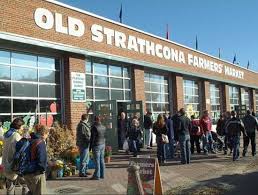 This coming weekend will be the first where Alberta beer and spirits producers are eligible to hawk their wares at local farmers’ markets. The Alberta government announced the change a couple weeks back (when I was on holidays, damn them!), which came into effect officially on August 15 (read the government announcement here).
This coming weekend will be the first where Alberta beer and spirits producers are eligible to hawk their wares at local farmers’ markets. The Alberta government announced the change a couple weeks back (when I was on holidays, damn them!), which came into effect officially on August 15 (read the government announcement here).
At the time of the announcement there were few regulatory details. I checked again this morning and the updated Gaming and Liquor Regulation was not yet posted, meaning I still don’t have answers on some of the niggly matters, such as whether growler pours will be allowed, size and number of samples allowed or other restrictions.
Regardless of those uncertainties, I wanted to comment on the general thrust of the new policy and what it might mean for brewers. Wineries (including meaderies) have been permitted in farmers’ markets for years and the double standard always seemed odd to me. I am glad there is now one consistent policy for all alcoholic beverages.
In provinces (including Saskatchewan and Nova Scotia) that have allowed beer sales at farmers’ markets for some time, the reviews have generally been positive. Breweries like the increased profile and the explicit association for their beer as locally produced, sitting alongside locally grown vegetables, locally produced handicrafts and other products.
What might the new opportunities mean for Alberta’s burgeoning craft beer scene? Both more and less than you think.
On the more front, having beer sold in farmers’ market has powerful symbolic effect. It is a firm indicator and reminder to consumers that beer is made locally. It further advances the associations with eating (and drinking) local, which can only enhance the craft beer industry in the province. It increases the profile of Alberta beer in general.
The less requires a bit more explanation. Setting up a stall in a local farmers’ market offers more in the way of profile for a brewery than actual sales. Selling a few dozen growlers and/or six packs on a Saturday morning (or Thursday evening or whenever) is nothing to sneeze at, but for most breweries it will not really move the needle in terms of overall sales.
The benefit lies in the opportunity to get your product in the hands of people who many not normally find you and to get your name out there more. To this end, my opinion is that the farmers’ market route is likely to benefit smaller and newer breweries more than the more established breweries. For Alley Kat, Wild Rose and even newer breweries who have already established some broad distribution such as Blindman and Bench Creek, their name is fairly well known and consumers will have already worked out where they can find their beer. The farmers’ market is just a convenient additional source.
Who would benefit the most are smaller operations. Imagine finding Bent Stick or Boiling Oar or Grain Bin at a local farmers’ market? Many customers will not know them and not found them in their local pub or liquor store yet. It will be a great first experience opportunity paired with – if they like the beer – a regular source for buying more (each week as they pick up eggs and new potatoes).
I don’t want to overstate my argument here. I recognize craft beer possesses less than 10% of the beer market (if we include Big Rock’s sales in that number). There is tonnes of room for growth. I know there are lots of people who still have not experienced Alley Kat or Wild Rose. But, relatively speaking, their brand is better known and product more widely available.
For many breweries they will do the math and decide a few hours of staff time and the cost of renting the stall are worth it for the extra sales and increased profile. Being at a farmers’ market each week has more upside (in terms of sales) than attending a beer festival where the patrons can’t buy beer to take home and will have to seek you out on their own later.
But I suspect many others will carefully consider and decide the marginal gains are not worth the extra effort. Either decision is fine with me.
Which is why I am emphasizing the symbolic importance of the decision. It not only corrects an historical inequity, it boldly tells consumers that beer is local food, too. And that is a very, very good thing.


Leave a Reply